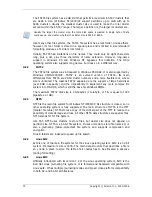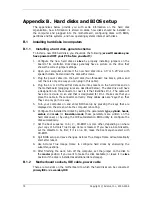
The hard disk with the jumper in
master
position is treated by the basic input/output
system (BIOS) as bootable.
The jumpers on hard disks that are connected to the same cable can be in the
cable
select for master/slave
position. In this case, BIOS will deem as «master» the disk
that is connected to the IDE cable closer to the motherboard than the other one.
Unfortunately, hard disk markings were never standardized. You might well find that
markings on your hard disk differ from the ones described above. Moreover, for the old
types of hard disks, their purpose could be defined by two jumpers instead of one. You
should study the markings carefully before installing your hard disk in the computer.
It is not enough to physically connect the hard disk to the motherboard and set the
jumpers properly for the hard disk to function — hard disks have to be properly
configured with the motherboard BIOS.
B.2 BIOS
When you turn on your computer, you often see a number of short text messages
before you see the splash screen of your operating system. These messages are
from the POST (power-on self test) program that belongs to BIOS and is executed
by the processor.
BIOS, or the basic input/output system, is a program that resides in the permanent
memory chip (ROM or flash BIOS) on the motherboard of your computer and is its
key element. The version of BIOS that you use «knows» all the peculiarities of all
the components of the motherboard: processor, memory, integrated devices. BIOS
versions are provided by the manufacturers of motherboards.
Main BIOS functions are:
•
POST checking of processor, memory and I/O devices
•
initial configuring of all software-manageable parts of the motherboard
•
initialization of operating system (OS) booting process
Among numerous components of the computer, initial configuration is necessary for
the external memory subsystem that controls hard disk drives, floppy disk drives,
CD-ROM drives, DVDs and other devices.
B.2.1 Setup
utility
BIOS has a built-in setup utility for initial computer configuration. To enter it, you
have to press a certain combination of keys (
Del, F1
,
Ctrl+Alt+Esc
,
Ctrl+Esc
, or
some other, depending on your BIOS) during the POST sequence that starts right
after you turn your computer on. Usually the message with the required
combination of keys is displayed during the startup testing. Pressing this
combination takes you to the menu of the setup utility that is included in your BIOS.
The menu can differ in appearance and sets of items and their names, depending
on the BIOS manufacturer. The most widely known BIOS makers for PC
motherboards are Award/Phoenix and AMI. Moreover, while items in the standard
setup menu are mostly the same for various BIOSes, items of the extended setup
heavily depend on computer and BIOS version.
Below we describe the general principles of initial hard disk configuration, and then
configuration (sample) in AwardBIOS.
74 Copyright © Acronis, Inc., 2000-2006








































